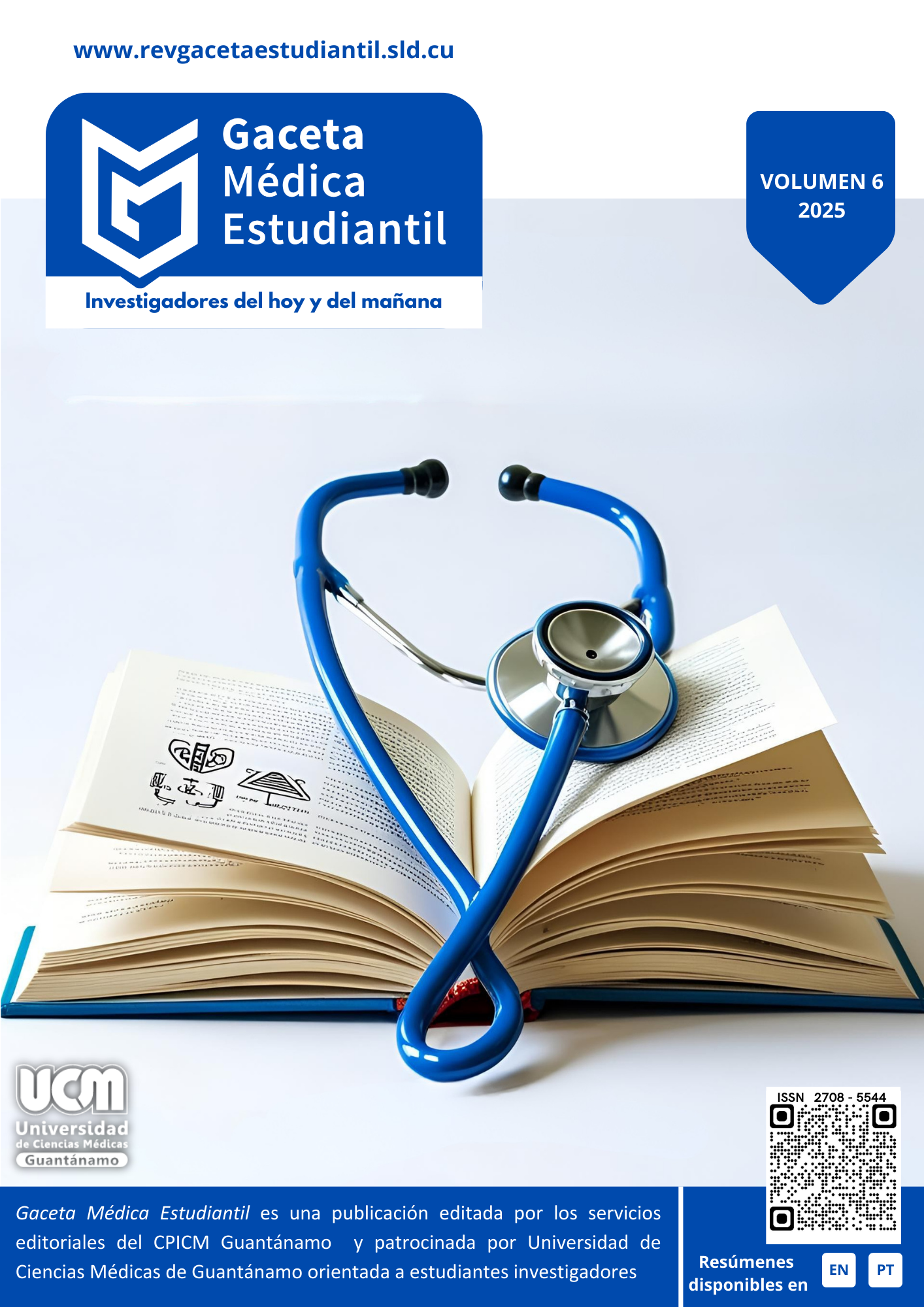Therapeutic options in patients diagnosed with hemolytic uremic syndrome
Keywords:
Hemolytic Uremic Syndrome, Emerging Therapies, Eculizumab, Typical and Atypical HUS, Evidence-based Clinical ManagementAbstract
Introduction: hemolytic uremic syndrome is a serious disease that primarily affects renal function and can present systemic complications. Its therapeutic management has evolved significantly in recent years, with the development of new strategies and therapeutic agents that seek to improve patient prognosis. Objective: describe the therapeutic management in patients diagnosed with hemolytic uremic syndrome. Methods: a bibliographic review was conducted using a retrospective, cross-sectional, observational analytical design, with information collected from scientific databases such as PubMed, ScienceDirect, and Elsevier. Development: in the management of typical hemolytic uremic syndrome, supportive therapy is based on isotonic volume expansion to correct diarrhea-induced hypovolemia, especially in normotensive patients without signs of fluid overload. In contrast, the treatment of atypical hemolytic uremic syndrome has advanced with the use of monoclonal antibodies, particularly eculizumab, which has demonstrated significant efficacy in controlling atypical forms and extrarenal manifestations. Conclusions: monoclonal antibodies, especially eculizumab, demonstrate significant efficacy in the treatment of atypical forms of hemolytic uremic syndrome and extrarenal manifestations; however, their therapeutic range in typical forms associated with ETEC is limited and controversial. Conservative treatment, aimed at adequate fluid therapy, is more advisable, avoiding the need for renal replacement therapy and reducing hospital admissions and mortality.
Downloads
References
1. Barrera Zambrano, N., Ratti Torres, A., Flores Subía, D., & Quiñonez García, K. (2020). Diagnóstico de síndrome urémico hemolítico. RECIAMUC, 4(3), 147-157. doi:10.26820/reciamuc/4.(3).julio.2020.147-157. DOI: https://reciamuc.com/index.php/RECIAMUC/article/view/508
2. Gülhan, B., Özaltın, F., Fidan, K., Özçakar, Z. B., & Söylemezoğlu, O. (2024). Management of pediatric hemolytic uremic syndrome. The Turkish journal of pediatrics, 66(1), 1–16. https://doi.org/10.24953/turkjped.2023.596
3. Viciconte, Micaela B., and Lucas Fernández Otero. "Síndrome urémico hemolítico del adulto." Rev. Hosp. Ital. B. Aires (2004) (2023): 17-20. DOI: http://doi.org/10.51987/revhospitalbaires.v43i1.193
4. Monteverde, M. L. (2014). Síndrome urémico hemolítico. Revista de nefrologia, dialisis y trasplante, 34(1), 27-41. DOI: https://www.revistarenal.org.ar/index.php/rndt/article/view/100
5. Sepúlveda Palamara, R. A., Modelli de Andrade, L. G., Fortunato, R. M., Gómez, B., & Nieto-Ríos, J. F. (2024). Clinical presentation and management of atypical hemolytic uremic syndrome in Latin America: a narrative review of the literature. Expert review of hematology, 17(7), 361–374. https://doi.org/10.1080/17474086.2024.2365169
6. Saavedra Valencia ME, Martinez-Sanchez LM, Vergara Yanez D, Arrieta Sibaja JD. Microangiopatías trombóticas: púrpura trombocitopénica trombótica y síndrome hemolítico urémico. Una revisión más allá del espectro clínico de la enfermedad. Acta Pediátrica de México. 2023 Agosto 7;44(4):312–22. https://ojs.actapediatrica.org.mx/index.php/APM/article/download/2290/1509
7. Bora Gülhan, Fatih Özaltın, Kibriya Fidan, Zeynep Birsin Özçakar, Oğuz Söylemezoğlu. Management of pediatric hemolytic uremic syndrome. The Turkish Journal of Pediatrics. 2024 Febrero 28;66(1):1–16. DOI: https://doi.org/10.24953/turkjped.2023.596
8. Cavero T, Trujillo H, Terente MP. Síndrome Hemolítico Urémico. Nefrologiaaldia.org. [citado el 29 de julio de 2024]. Disponible en: https://www.nefrologiaaldia.org/es-articulo-sindrome-hemolitico-uremico-628-pdf
9. Sepúlveda Palamara RA, Modelli de Andrade LG, Fortunato RM, Gómez B, Nieto-Ríos JF. Clinical presentation and management of atypical hemolytic uremic syndrome in Latin America: a narrative review of the literature. Expert Rev Hematol [Internet]. 2024;17(7):361–74. Disponible en: http://dx.doi.org/10.1080/17474086.2024.2365169
10. Gurevich E, Landau D. Pharmacological management of atypical hemolytic uremic syndrome in pediatric patients: Current and future. Paediatr Drugs. 2023;25(2):193–202. Disponible en: http://dx.doi.org/10.1007/s40272-022-00555-6
11. Mauch TJ, Chladek MR, Cataland S, Chaturvedi S, Dixon BP, Garlo K, et al. Treatment preference and quality of life impact: ravulizumab vs eculizumab for atypical hemolytic uremic syndrome. J Comp Eff Res. 2023;12(9). Disponible en: http://dx.doi.org/10.57264/cer-2023-0036
12. Kurihara S, Yamaguchi A, Sonoda K, Yamada Y, Harada M, Hashimoto K, et al. Anti-C5 monoclonal antibody treatment showing pathological resolution of complement-mediated atypical hemolytic uremic syndrome: a case report. BMC Nephrol. 2024;25(1). Disponible en: http://dx.doi.org/10.1186/s12882-024-03662-3
13. López Maldonado, M., Molina Fernández, J., Mayo Salazar, S., & Matute Potosí, E. (2023). Síndrome hemolítico urémico en pacientes pediátricos, un artículo de revisión. Polo del Conocimiento, 8(9), 287-299. doi:https://doi.org/10.23857/pc.v8i9.6015
14. Bentancor, Adriana. (2016). Síndrome urémico hemolítico en áreas urbanas. Revista argentina de microbiología, 48(1), 1-4. https://dx.doi.org/10.1016/j.ram.2016.03.001
15. Balestracci, A., Meni Battaglia, L., Martin, S. M., Toledo, I., Puyol, I., Beaudoin, L., & Robledo, N. L. (2021). Síndrome urémico hemolítico por Escherichia Coli e hipocomplementemia con respuesta favorable a eculizumab: comunicación de un caso [Hemolytic uremic syndrome due to Shiga toxin–producing Escherichia coli and hypocomplementemia with favorable response to eculizumab: a case report]. Revista de la Facultad de Ciencias Medicas (Cordoba, Argentina), 78(2), 188–192. https://doi.org/10.31053/1853.0605.v78.n2.29934
Downloads
Published
How to Cite
Issue
Section
License
Copyright (c) 2025 Alex Ramón Valencia-Herrera, David Nicolás Buenaño-Carrillo, Melany Mishell Velasco-Basantes, Melany Jhaslady Moreano-Camalli

This work is licensed under a Creative Commons Attribution-NonCommercial 4.0 International License.
The Gaceta Médica Estudiantil magazine provides immediate Open Access to its content. It is published under a Creative Commons Attribution-NonCommercial 4.0 International (CC BY-NC) license, which allows sharing (copying and redistributing the material in any medium or format) and adapting (remixing, transforming, and building upon the material), under the terms of acknowledge authorship and not make commercial use of the materials.












